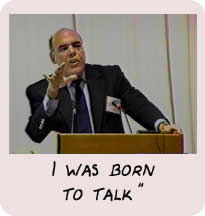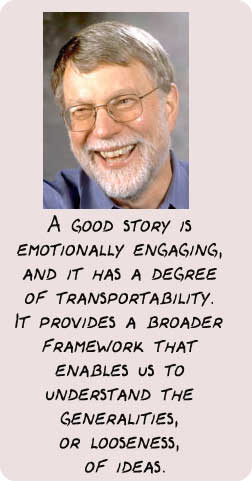|
|
Katalina Groh, Larry Prusak: Some of the world's leading thinkers |
| How we found ourselves in the world of storytelling |
 |
Larry
Prusak
I was born to talk. I was a college teacher. I am from New York. In New York City, you had to be either a good fighter or a fast talker. That was the only way I could survive. I wasn’t much of a fighter. But I could really talk. |
 |
John
Seely Brown
When I was a child, I became angry with my mother because she had urged me to read a novel. Full of adolescent certainty, I told her "When that author understands his own ideas well enough to write an equation, then I'll read that novel. Because all I have to do is read an equation, and five minutes later I've got it." I'm happy to say that such dogmatism has not stuck with me. As a scientist, I moved from equations and formulas to artificial intelligence, and from there to a growing appreciation of the power of the narrative - the power of realizing that generalities are different from abstraction. After all, what do we know now that we didn't know ten years ago? That learning and knowledge are the result of multiple intertwining forces: content, context, and community. In the knowledge economy, the real formula for success (which is, of course, less mechanistic than an equation) calls on the need to learn continuously. And to learn continuously, we must learn to see, and do, things differently. We learn through conceptual frameworks, and we can continue to expand our knowledge incrementally within these existing frameworks. |
| But if we are to create new frameworks
and see new opportunities, our evolving world calls on us to challenge
the assumptions or which our traditional intellectual constructs rest.
Furthermore, it is important to understand that learning is less about absorbing information than it is about becoming part of a community. Diversity of experience and practice, therefore, is paramount. For what better way is there to foster a different perspective than to see that perspective from another person's point of view? Consider Silicon Valley, London's theater district, or New York's financial district. All are dominant locales in their respective fields, and communities of practice exist within each of these locales. Members of these communities are bound together by both a sense of purpose and the need to know what each other knows. They communicate with each other and share knowledge via a web of overlapping personal networks. These locales benefit from the porous relationships (which enable the flow of information) among their many communities. In an environment of complex symbiosis and social reciprocity, partners and competitors alike benefit from the movement of people and ideas. But where the rubber hits the road is in negotiations between communities. Inside a community, ideas are validated by the shared practice or paradigm of that community. Taking an idea outside the community requires the testing not just of the idea but of the paradigm itself. Negotiations between communities, therefore, make knowledge more robust and force us to understand the barriers to knowledge sharing. By being able to see differently and to create new perspectives through diversity, new knowledge is constructed. The key? Understanding the knowledge construction process and harnessing and leveraging the diversity found in such communities. What are the dynamics underlying the construction of wealth? The construction of the firm? The construction of self? How do those things come together, and how do firms come to understand and leverage these knowledge dynamics? At Xerox PARC, there is a group of people we call "knowledge artists." The role of knowledge artist, someone who can describe or present what he sees differently, may become a new and important discipline in the knowledge workplace. Artists are known for their ability to bring life to an idea or concept. Our knowledge artists at Xerox intermingle with the scientists, grafting visual performances that contribute to the construction, sharing, and leveraging of knowledge. By presenting a perspective from a different point of view, or by introducing a new perspective altogether, knowledge artists provide new frameworks, bring learning to life, and further enrich the diversity of knowledge and ideas within the organization. Ideas, and knowledge, are usually constructed with the help of a document or book. A document does not contain knowledge; it contains information. But documents put into motion a dynamic of social reciprocity, in which knowledge is shared and social construction of understanding takes place. Documents evoke reactions and creations in the knowledge construction process. What's more, documents are not independent. Every document is, in some way, related to another (as illustrated by footnotes, annotations, and textual references to previous works and other authors). But perhaps most important, shared documents often provide the basis for disagreement within communities - thereby representing not the ending, but the beginning of the process of negotiation, learning, and knowledge-sharing. And as my mother attempted to teach me, storytelling too enriches the sharing of knowledge. A good story is emotionally engaging, and it has a degree of transportability. It provides a broader framework that enables us to understand the generalities, or looseness, of ideas. Stories can be embedded in a new context, and the nuggets of knowledge contained in these stories can be applied to a new range of settings. Stories are transported and resuscitated through the process of listening, which goes hand in hand with storytelling. Because a story is interactive, the listening is as much an activity as the telling. We call this "deep listening." One of the things organizations must discover is how to construct a context, a space in the corporate world. Even a scientist (such as I) must admit that knowledge cannot be captured via a formula or equation. It calls for new intellectual constructs and the challenge of background assumptions. And it is enriched by events, objects, people, or situations — such as storytelling, documents, knowledge artists, and communities of practice — that provide us with different perspectives and lenses through which to view the world. From the The Knowledge Advantage: 14 Visionaries Define Marketplace Success in the New Economy, edited by Rudy Ruggles and Dan Holtshouse (Catpstone, 1999). Copyright © Ernst & Young 1999. Foreword by John Seely Brown, Xerox PARC (Permission to be obtained) |
| Books and videos on storytelling *** In Good Company : How Social Capital Makes Organizations Work by Don Cohen, Laurence Prusak (February 2001) Harvard Business School Press *** The Social Life of Information, by John Seely Brown, Paul Duguid (February 2000) Harvard Business School Press *** The Springboard : How Storytelling Ignites Action in Knowledge-Era Organizations by Stephen Denning (October 2000) Butterworth-Heinemann *** The Art of Possibility, a video with Ben and Ros Zander : Groh Publications (February 2001) |
| The views expressed on this website are those of the authors, and not necessarily those of any person or organization |
| Site optimized in 800x600: webmaster CR WEB CONSULTING |
|
|
|
|